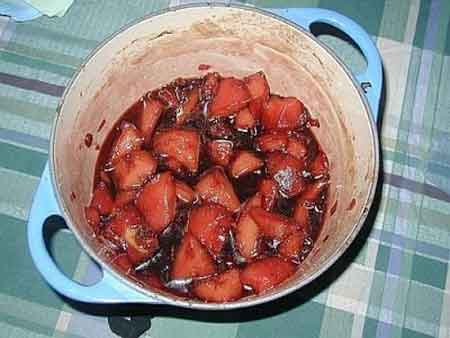Roman recipes
Ut mala Cydonia diu serventur
(Honeyed quinces)
by Apicius I, 21

Unlike honeyed dates. Cairene quince preserves could not be considered sweets, although made by a similar technique. As their sweetness had sour-savory flavor, quince preserves were closer to fruit Chutneys than to sweet jams. Due to their high pectin content, quinces, like grapes, are ideal for making preserves: when cooked, they would gel into a substance of relatively firm texture!” The Mediterranean-Near Eastern world knew of this property and used it to make preserves of both quinces and grapes. To make the preparation richer, quinces could be cooked in honey or a sugar solution to which vinegar, spices, ground pistachios and almonds were added.
Original recipe: Eligis mala sine vitio cum ramulis et foliis, et condes in vas, et suffundes mel et defritum, et diu servabis.
Translation: Pick out perfect quinces with stems and leaves [the stems, if removed, would leave a wound in the fruit for the air to penetrate and to start fermentation]. Place them in a vessel, pour over honey and defrutum and you'll preserve them for a long time.
Ingredients
- 10 quinces (Pears can be substituted but quinces are tarter. If using pears reduce the honey by 1/3 and add the juice of half a lime)
- 100 ml/3 fl oz honey
- 250 ml/9 fl oz sweet white wine
Preparation
- Peel, core, dice the quinces and put them in a pan.
- Pour the wine and honey over the quinces, then simmer gently with the lid on for 30 minutes or until they are soft (reduce the time for pears).
- Transfer the quinces to a blender and puree.
- Pour the quince puree into individual glass bowls. You can chill this puree in the fridge.




















